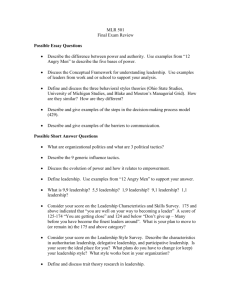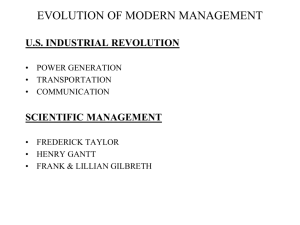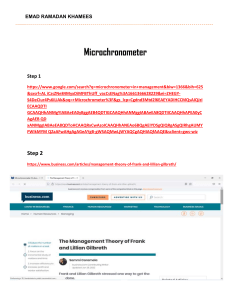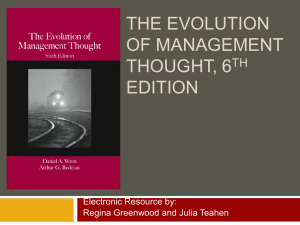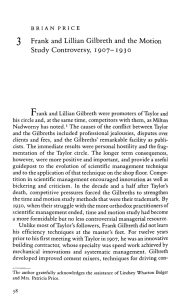planning & decision making - Institute of Business Management
advertisement
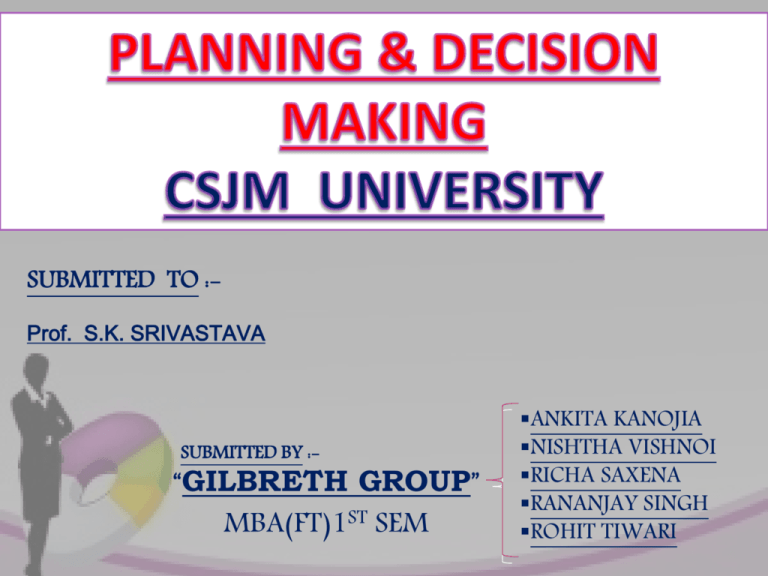
SUBMITTED TO :Prof. S.K. SRIVASTAVA SUBMITTED BY :- “GILBRETH GROUP” MBA(FT)1ST SEM ANKITA KANOJIA NISHTHA VISHNOI RICHA SAXENA RANANJAY SINGH ROHIT TIWARI Frank and Lillian Gilbreth’s Contribution to Modern Management A mechanical engineer, Frank Gilbreth is considered by many to be the Father of Management Engineering. Born (1868-1924) Frank and wife Lillian Gilbreth (18781972). They married in 1904. In addition to raising 12 children and being the subject of the Hollywood movie, Cheaper by the Dozen, they became one of the great husband-wife teams of science and engineering. Frank and Lillian Gilbreth worked together to develop motion study as an engineering and management technique. PLANNING WE WILL DISCUSS ABOUT MEANING CHARACTERSTICS TYPES STEPS ADVANTAGES AND DISADVANTAGES MEANING OF PLANNING What is Planning ? “Planning is an activity. It can be considered as consisting to a process. Planning involves course of action.” i.e. WHAT HOW WHEN WHY According To Terry- ‘’Planning is the selection and relating of facts and making using of assumption regarding the future in the visualization and formalization of proposed activity believed necessary to achieve desire results.” “ Some other views on ‘PLANNING’…..” CHARACTERISTICS OF PLANNING Planning is goal-oriented. Planning is looking ahead. Planning is an intellectual process. Planning involves choice & decision making. Planning is the primary function of management. Planning is a Continuous Process. Planning is designed for efficiency. Planning is Flexible. TYPES OF PLANS CORPORATE FUNCTIONAL STRATEGIC OPERATIONAL LONG TERM SHORT TERM PROACTIVE FORMAL REACTIVE INFORMAL Corporate Planning includes the setting of objectives, organizing the work, people and systems to enable those objectives to be attained through the planning process. Functional Planning is undertaken for each major function of the organization like production, marketing, human resource etc to determine their respective objectives. Strategic Planning sets the long term direction of the organization in which it wants to proceed in future is and guide what an organization is, who it serves, what it does and why it does it, with a focus on the future. Operational Planning should establish the activities, process of deciding the effective use of resources. They link the strategic plan with the activities the organization will deliver and the resources required to deliver them. SHORT TERM PLANNING & LONG TERM PLANNING Short Term Planning involves deciding what your goals are for the short term (usually covers 1 year). These short term goals may include restructuring, hiring or short term profit targets, marketing and production. Long Term Planning may involve an outlook for the future (in the next 5 to 10 years). This may involve a capital funding goal or company expansion goals. PROACTIVE AND REACTIVE PLANNING In Proactive Planning Organization do not wait for environment to change but take actions in advance of environment change. In Reactive Planning Organizations responses come after the environment changes have taken place. In such situations the organization lose opportunities. FORMAL AND INFORMAL PLANNING Formal planning is in the form of well structured process involving different steps . Generally large organizations undertake planning in the formal way. Informal planning is based on manager’s memory of events, intuitions and gut-feelings rather than based on systematic evaluation of environmental Happenings. Establish ment of objectives Establishing sequence of activities Formulation of supporting plans Steps of Planning Function Establish ment of Planning Premises Identificat-ion of alternatives 1. 2. 3. 4. 5. Planning facilitates management by objectives. Planning minimizes uncertainties. Planning facilitates co-ordination. Planning facilitates controlling. Planning provides competitive edge and encourages innovations. Disadvantages of Planning 1. 2. 3. 4. 5. Rigidity. Misdirected Planning. Time consuming. Probability in planning. False sense of security. MEANING CHARACTERSTICS TYPES STEPS MODEL ADVANTAGES What is Decision Making ? A decision is a choice made from available alternatives. Decision making is the process by which individuals select a course of action among several alternatives, to produce a desired result. According to Trewatha & Newport, "Decision-making involves the selection of a course of action from among two or more possible alternatives in order to arrive at a solution for a given problem". 1.Decision making implies choice: Decision making is choosing from among two or more alternative courses of action. Thus, it is the process of selection of one solution out of many available. 2.Continuous activity/process: Decision-making is a continuous and dynamic process. 3. Mental/intellectual activity: Decision-making is a mental as well as intellectual activity/process and requires knowledge, skills, experience and maturity on the part of decision-maker. It is essentially a human activity. 4. Based on reliable information/feedback: Good decisions are always based on reliable information. 5. Goal oriented process: Decision-making aims at providing a solution to a given problem/ difficulty before a business solutions to problems faced by a business unit. PROGRAMMED DECISIONS Problems are routine and repetitive Highly certain Made by lower level people NON PROGRAMMED DECISIONS Problems are unique and novel Highly uncertain Top management responsibility STRATEGIC AND TACTICAL DECISION STRATEGIC DECISION TACTICAL DECISION Strategic decision is based on It relate to the day to day Strategic which is a major operations of the organization action plan in an organization. and has to be taken very Strategic decision is a major choice of action concerning allocation of resources. frequently. Tactical decision is mostly programmed one. THE DECISION-MAKING PROCESS INVOLVES THE FOLLOWING STEPS MODEL OF DECISION MAKING TWO BASIC MODEL OF DECISION MAKING RATIONAL MODEL SIMON’S NORMATIVE MODEL 1.Decision making is the primary function of management 2.Decision-making facilitates the entire management process 3.Decision-making is a continuous managerial function 4.Decision-making is essential to face new problems and challenges 5.Decision-making is a delicate and responsible job CHECK Presented by:GILBERT’S GROUP

